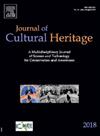Development and application of affordable microclimate and indoor air quality monitoring platforms for historic libraries in cultural heritage preservation
IF 3.5
2区 综合性期刊
0 ARCHAEOLOGY
引用次数: 0
Abstract
The present study deals with the development and application of innovative, low-cost devices designed to monitor indoor air quality in historical libraries which is fundamental for the preservation of historical items. Due to the complexity of managing multiple instruments, it is the thermo-hygrometric parameters that are usually monitored in historical libraries rather than the gaseous contaminants. Furthermore, these indoor environments often include users and staff who could potentially be disturbed by these monitoring activities. In this context, two compact and low-cost air quality platforms are presented. The first device was engineered to monitor multi-point temperature and relative humidity and the second was designed to monitor thermo-hygrometric parameters along with concentrations of key air quality pollutants (CO2, NOx, O3, VOCs, and PM10). These devices were first tested and then trialed in two distinct conservation institutes in Rome, Italy: the Bibliotheca Angelica, and the Archive of the Institute for the History of the Italian Risorgimento. Each institute presented unique characteristics and challenges, offering a diverse range of environments for evaluating the effectiveness of the adopted technical solutions. The obtained data were also used to investigate the relationship between indoor and outdoor environments, which is crucial as it can indirectly affect the preservation of cultural heritage items inside historical libraries or archives. The results demonstrated the effectiveness of the adopted low-cost technical solutions in providing valuable and reliable data for the preservation of cultural heritage, offering insights into the current state of the studied indoor environments.
在文化遗产保护中为历史图书馆开发和应用经济实惠的微气候和室内空气质量监测平台
本研究涉及创新型低成本设备的开发和应用,这些设备旨在监测历史图书馆的室内空气质量,这对历史物品的保存至关重要。由于管理多种仪器的复杂性,历史图书馆通常监测的是温度湿度参数,而不是气体污染物。此外,这些室内环境通常包括用户和工作人员,他们可能会受到这些监测活动的干扰。在此背景下,介绍了两个结构紧凑、成本低廉的空气质量平台。第一个设备用于监测多点温度和相对湿度,第二个设备用于监测温度-湿度参数以及主要空气质量污染物(二氧化碳、氮氧化物、臭氧、挥发性有机化合物和 PM10)的浓度。这些设备首先进行了测试,然后在意大利罗马的两个不同的文物保护机构进行了试用:天使图书馆和意大利复兴史研究所档案馆。每个机构都具有独特的特点和挑战,为评估所采用的技术解决方案的有效性提供了不同的环境。获得的数据还用于研究室内和室外环境之间的关系,这一点至关重要,因为它可能间接影响历史图书馆或档案馆内文化遗产物品的保存。研究结果表明,所采用的低成本技术解决方案在为文化遗产保护提供有价值的可靠数据方面非常有效,并为所研究的室内环境现状提供了见解。
本文章由计算机程序翻译,如有差异,请以英文原文为准。
求助全文
约1分钟内获得全文
求助全文
来源期刊

Journal of Cultural Heritage
综合性期刊-材料科学:综合
CiteScore
6.80
自引率
9.70%
发文量
166
审稿时长
52 days
期刊介绍:
The Journal of Cultural Heritage publishes original papers which comprise previously unpublished data and present innovative methods concerning all aspects of science and technology of cultural heritage as well as interpretation and theoretical issues related to preservation.
 求助内容:
求助内容: 应助结果提醒方式:
应助结果提醒方式:


